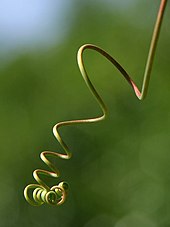
Back Filo (botanica) AN محلاق Arabic Vėrkštė BAT-SMG Circell Catalan Úponek Czech Ranke German Ĉiro Esperanto Zarcillo Spanish Köitraag Estonian ساقهپیچک Persian

In botany, a tendril is a specialized stem, leaf or petiole with a threadlike shape used by climbing plants for support and attachment, as well as cellular invasion by parasitic plants such as Cuscuta.[1] There are many plants that have tendrils; including sweet peas, passionflower, grapes and the Chilean glory-flower.[2] Tendrils respond to touch and to chemical factors by curling, twining, or adhering to suitable structures or hosts. Tendrils vary greatly in size from a few centimeters up to 27 inches (69 centimeters) for Nepenthes harryana[3] The chestnut vine (Tetrastigma voinierianum) can have tendrils up to 20.5 inches (52 centimeters) in length. Normally there is only one simple or branched tendril at each node (see plant stem), but the aardvark cucumber (Cucumis humifructus) can have as many as eight.[4]
- ^ "Plants: A Different Perspective". content.yudu.com. Archived from the original on 2017-02-17. Retrieved 2018-01-09.
- ^ "How Plants Climb - Climbing Plants & Vines | Gardener's Supply". www.gardeners.com. Retrieved 2022-04-27.
- ^ Kurata, Shigeo (1976). Nepenthes of Mount Kinabalu. Kota Kinabalu, Malaysia: National Parks Trust. p. 47.
- ^ Kilbride Jr., Joseph H. (1993). Biosystematic Monograph of the Genus Cucumis. Bonne, No. Carolina: Parkway Publishers. p. 77.
© MMXXIII Rich X Search. We shall prevail. All rights reserved. Rich X Search